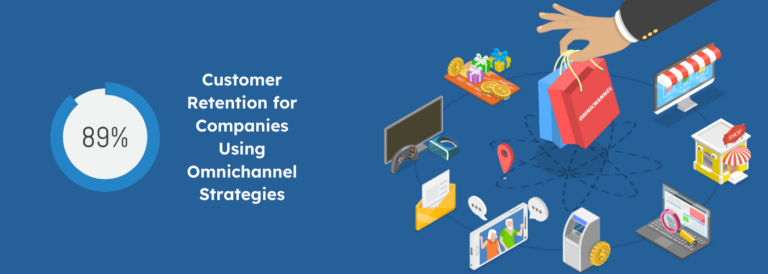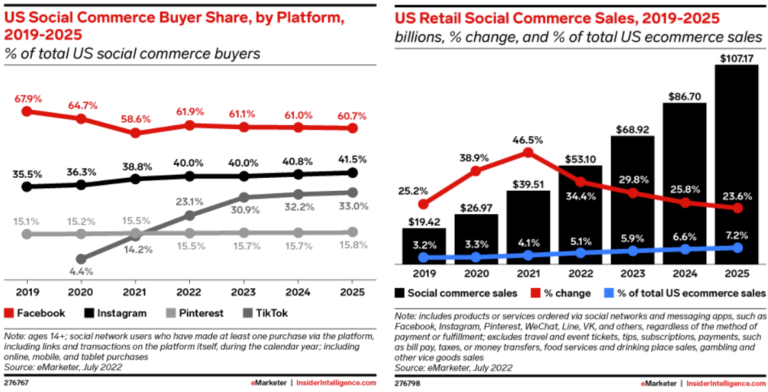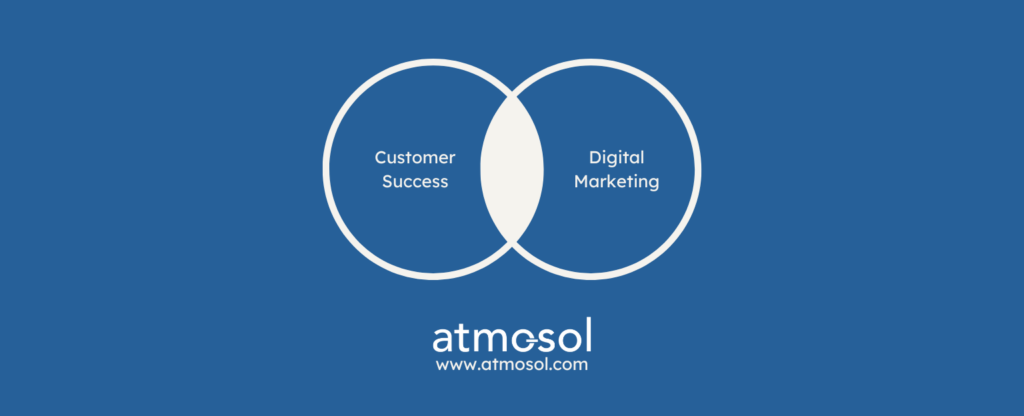Artificial intelligence (AI) algorithms are transforming the way we shop. ECommerce customization has become an important tool for organizations, allowing them to provide customized experiences, personalized product suggestions, and individualized marketing communications to clients. AI personalization has become a key strategy for increasing customer engagement and loyalty as customer demands evolve. According to Notta.ai, 83% of company executives claim that using AI is a strategic priority for their business.
The Role of AI in eCommerce Personalization
The realm of eCommerce personalization has witnessed remarkable progress, all thanks to the remarkable advancements in artificial intelligence (AI) and machine learning algorithms. These cutting-edge algorithms meticulously analyze extensive customer data, enabling businesses to extract invaluable insights into customer behavior, preferences, and individual shopping experiences. With these insights, eCommerce enterprises can now provide personalized shopping experiences tailored to each customer’s preferences. As a result, this leads to heightened customer satisfaction, increased engagement, and unwavering loyalty.
Understanding AI Personalization in eCommerce
Using customer names is just the beginning of AI personalization in eCommerce. It entails picking up on their likes and dislikes and catering to them specifically when they purchase. Artificial intelligence systems can reliably forecast consumer tastes by examining data such as previous purchases and web surfing habits. Because of this, companies may provide customers with tailored product suggestions, dynamic pricing, and advertising messages. Customers feel understood and involved in this customization, producing a smooth purchasing experience.
An assortment of channels, including interactions with the online shop, social media, and customer support chats, may be utilized by eCommerce enterprises to gather client data. Artificial intelligence systems sift through this data, revealing consumers’ tastes, behaviors, and buying patterns. By utilizing this information, organizations can tailor their marketing efforts, product suggestions, and content strategies to create an experience tailored to each consumer.
What is the Impact of AI on eCommerce Growth?
The advantages of AI personalization in eCommerce are numerous. Personalization, which uses demographic information, enables firms to personalize their services and suggestions to specific clients. This improves the overall shopping experience while increasing customer happiness and loyalty. Furthermore, personalization can help organizations improve their marketing tactics by sending out tailored messages and discounts depending on customer preferences. Finally, personalization in eCommerce can result in improved conversion rates and increased business revenue. According to a Twilio Segment report, 92% of businesses use AI-driven personalization to provide personalized customer experiences.
AI-driven personalization strategies enable businesses to swiftly provide pertinent product recommendations, resulting in increased conversion rates and recurring purchases. By scrutinizing customer data points like past purchases, browsing patterns, and style preferences, AI algorithms can precisely propose products that resonate with individual customer tastes. This heightened personalization amplifies customer satisfaction and augments the probability of transforming potential customers into buyers, ultimately propelling sales and revenue.
Furthermore, AI personalization allows organizations to produce personalized marketing messages based on customer preferences. Businesses may effectively engage clients, increase brand loyalty, and stimulate repeat purchases by sending targeted marketing communications. Customers feel more connected to firms that understand their needs, which leads to long-term customer loyalty and brand advocacy.

Key Benefits of AI eCommerce Personalization
Customization in eCommerce powered by AI has many benefits for companies and customers. To begin, it improves the buying process for the customer by giving them unique product suggestions, custom content, and relevant search results. This not only gets customers more involved, but it also makes them happier.
Second, it boosts sales and income by making it easier to find products and increasing the number of people who buy them. Customers are more likely to buy something when they see goods that meet their wants and needs.
Third, it helps companies get the most out of their goods and supply chain management. By correctly predicting demand, they can escape the problems of having too much or too little stock.
AI-driven customization also improves the targeting and segmentation of customers for marketing efforts, making ads more effective and less expensive. Lastly, it makes customers more loyal and helps you keep them. Customers are more likely to return to an eCommerce platform that regularly provides personalized and easy shopping experiences. This leads to long-term business growth and success.
Enhanced Customer Experience through AI
AI personalization algorithms enhance the customer experience by customizing interactions, suggestions, and content based on individual customer preferences. Businesses that comprehend their customers’ distinct needs and preferences make them feel appreciated, leading to higher satisfaction and loyalty.
Through customer data analysis, AI algorithms can deliver personalized experiences that align with each customer’s preferences, style, and behavior. Whether it’s personalized product recommendations, flexible pricing, or customized marketing messages, AI personalization ensures a unique and engaging experience that customers find enjoyable and relevant.
Increasing Customer Engagement with AI
AI-powered customization tactics transform client interaction by delivering tailored marketing messages over many channels. Businesses that tailor marketing messages to particular consumer preferences can pique customers’ curiosity, build brand loyalty, and increase engagement rates.
Businesses may use AI-powered customization algorithms to perform customized marketing efforts that profoundly resonate with clients on a personal level. Whether through individualized email marketing or social media retargeting, AI personalization ensures clients receive marketing messages relevant to their specific requirements and interests. This, in turn, leads to more engagement, better conversion rates, and higher customer happiness.
Improved Conversion Rates and Sales
AI-driven personalization strategies significantly impact the conversion rates and sales of eCommerce companies. One example is production recommendations. Advanced algorithms carefully analyze customer preferences, purchase history, and browsing behavior to generate highly personalized product recommendations.
By highlighting products that resonate with personal preferences, businesses can enhance the chances of customers making meaningful purchases, directly impacting conversion rates. This customized strategy improves the shopping experience, increasing the likelihood of customers purchasing. By increasing conversion rates, firms can boost revenue growth and accomplish their business objectives.
Reducing Cart Abandonment with AI Personalization
AI personalization is a valuable tool that can help companies tackle the problem of cart abandonment by customizing the shopping experience for each user. By utilizing advanced algorithms and data analysis, AI can examine user behavior, preferences, and past interactions to understand why a potential customer decides to abandon their shopping cart.
AI-powered email campaigns are designed to send personalized messages to users who abandoned their carts. These emails may include specific product recommendations, limited-time discounts, or personalized incentives based on the user’s preferences and behavior, encouraging them to return and complete their purchase. A blog by Klaviyo stated their customers had the following abandoned cart rates: open rates-34.5%, click rates-7.5%, recovery rates-4%, and RPR-$8.25.
Also, AI-driven chatbots can engage with users who abandon their carts, providing instant assistance and addressing any concerns or questions they may have. Chatbots can offer personalized recommendations, assist with checkout, or even provide special promotions, guiding users back to complete their purchases.
Building Customer Loyalty and Retention through AI
AI personalization strategies contribute to building customer loyalty and retention in eCommerce businesses. By delivering personalized experiences, businesses can create a sense of loyalty and connection with their customers, resulting in repeat purchases and long-term customer relationships.
AI can enhance loyalty programs by carefully examining customer behavior and preferences. Using AI makes it possible for rewards and incentives to change based on real-time customer interactions and comments. Websites that use AI can change their content based on what users like and how they use the site. For example, a news website can give priority and show articles in real-time according to a user’s past reading preferences.
Cross-device personalization
Cross-device personalization means changing how a user experiences something on different devices without problems. Using the power of artificial intelligence, businesses can analyze massive amounts of data from various sources like laptops, tablets, smartphones, and wearable devices.
Artificial intelligence systems may analyze massive volumes of data from various devices, such as computers, tablets, phones, and wearable technology, with amazing speed. Through analyzing consumer device usage, AI can effectively anticipate their requirements and provide customized suggestions and relevant information. AI can identify a user’s location, time, and device, enabling timely and tailored experiences. Using artificial intelligence, user interfaces may automatically adapt to users’ preferences and actions.
This leads to optimizing the user experience on all platforms, including layout modifications, information reorganization, and improved navigation.

Personalization Trends in eCommerce
As AI personalization continues to evolve, new trends are emerging in the eCommerce industry. These trends are shaping the future of eCommerce personalization, enabling businesses to stay ahead in the competitive landscape.
Omnichannel eCommerce Personalization
Omnichannel personalization involves customizing a single individualized customer experience across several channels and touchpoints, including websites, mobile apps, social media, email, and in-store encounters. AI systems process extensive datasets from diverse sources, encompassing online and offline interactions. The data may encompass user demographics, browsing history, purchasing habits, and additional information. Artificial intelligence facilitates immediate customization by consistently evaluating user behavior during ongoing sessions.
AI improves omnichannel personalization by analyzing extensive data, detecting patterns, forecasting user behavior, and enabling immediate customization across several channels, resulting in a more captivating and customized user experience. An example of how Klevu helped an omnichannel company increase their conversions by 20% on mobile and tablet can be read here.
Headless Personalization
Headless architecture separates front-end and back-end components in an application, allowing them to function independently. This separation allows for increased flexibility in delivering information and user experiences. By separating these components, content can be distributed across different channels and devices, including websites, mobile apps, and Internet of Things (IoT) devices.
AI plays a crucial role in headless personalization by using machine learning algorithms to analyze user behavior, preferences, and historical data. Headless architectures rely on APIs to deliver content or data. To learn about AI Search and Product Discovery, explore Klevu’s Headless Architecture.
AI-powered recommendation engines utilize complex algorithms to offer personalized suggestions for content, products, or services based on user preferences. A/B testing becomes easier with AI as it can automatically analyze user responses to different content variations, layouts, or features. This enables continuous optimization to improve personalization and user engagement.
Voice Search and Marketing Strategies
Artificial intelligence and AI personalization in the eCommerce industry are continuously evolving. Predicting future trends in AI personalization can help businesses stay ahead of the competition and deliver exceptional customer experiences.The eCommerce industry is witnessing ongoing advances in artificial intelligence and AI personalization. Forecasting upcoming trends in AI personalization enables businesses to gain a competitive edge and provide outstanding customer experiences.
One of the upcoming trends is the growing adoption of AI-powered voice search optimization. With the increasing prevalence of voice assistants, businesses prioritizing voice search optimization will gain a significant edge over their competitors. AI-powered algorithms analyze user behavior and historical data to understand individual preferences and intent behind voice searches. Also, AI uses tools to help optimize content for voice search by understanding the natural language queries users make through voice-enabled devices.
The marketing industry has significantly transformed due to AI algorithm advancements, radically changing how firms engage with their intended customer base. Examining extensive data sets, these algorithms offer marketers significant insights into customer behavior and preferences. Through advanced machine learning algorithms, marketers can create hyper-personalized campaigns that resonate with individual consumers profoundly. The days of generic, one-size-fits-all advertising are fading into obsolescence as AI enables crafting messages that speak directly to each target audience’s unique needs and desires
The Future of AI Personalization in eCommerce
As we look ahead, the future of AI personalization in eCommerce holds great potential. A wide range of exciting trends and advancements in artificial intelligence, marketing strategies, and customer experiences are on the horizon.
Overcoming Challenges in AI Personalization
AI personalization presents a range of benefits, yet it also brings about obstacles that businesses need to overcome to thrive. Yet according to Notta.ai, nearly 74% of company executives believe the benefits of AI outweigh the risks.
One of the challenges businesses face is data privacy and security concerns. Given the growing dependence of businesses on customer data, it becomes imperative for them to adhere to the expectations of customers and regulators. This is particularly true regarding safeguarding personal data and establishing a strong foundation of customer trust.
Another challenge involves the need for highly skilled professionals who can proficiently utilize machine learning algorithms to analyze customer data and extract valuable insights. To fully maximize the potential of AI personalization, businesses must make a dedicated effort to train and develop AI talent within their organizations.
Finally, businesses must find a middle ground between providing personalized experiences and retaining human oversight. Although AI algorithms can streamline and enhance personalization efforts, there is a potential downside of overlooking potential opportunities or not aligning with the overall business strategy without human involvement. Striking the perfect balance guarantees that AI personalization improves the customer experience while aligning with the brand’s mission and objectives.
How Can Retailers Stay Ahead With AI Innovations?
AI can help retailers change how they do business, improve the customer experience, and make business processes run more smoothly. AI lets retailers look at huge amounts of data using advanced analytics. This helps them understand what customers want, predict trends, and make choices based on data. AI algorithms that run personalized suggestions and focused marketing campaigns can make customers more interested and loyal.
AI personalization strategies also let retailers make relevant material, personalized communications, and smart product suggestions. Businesses can increase customer engagement, happiness, and loyalty by giving personalized experiences. This will eventually lead to higher online conversion rates and repeat purchases.
Using AI innovations, stores can become stars in their fields and give customers unique, personalized experiences that make them want to return. As customers’ tastes change, AI innovations give stores the tools they need to adapt, come up with new ideas, and do well in a retail world that is always changing.
AI and the Evolution of eCommerce
Artificial Intelligence has been very important in the growth of eCommerce, which has led to big steps forward in this area. The algorithms have improved personalized shopping experiences by creating personalized content, suggesting goods, and implementing targeted marketing plans.
Also, AI-powered chatbots are easily available to answer customer questions, give product information, and help with shopping. These algorithms can also change prices based on supply and demand, prices set by competitors, market factors, and how customers act. According to a case study by Gorgias, Kirby Allison got 25% more conversions, 46% more sales from support, and 30% more ticket deflection by using automation.
Businesses can improve their marketing strategies by using AI in eCommerce to segment customers, use predictive analytics, and automate ad placements. In the eCommerce industry, AI’s ability to look at and make sense of huge amounts of data is very useful.
Deep learning systems will one day be able to make shopping even more personalized. To meet customer needs successfully, it is important to comprehend their preferences fully. Customized ideas, tailored content, and product suggestions can be given by looking at the customer’s mood.
Virtual reality (VR) and augmented reality (AR) could change how people connect with products and customer service when combined with AI. It will get more realistic for virtual try-ons, and AI helpers can give personalized help in a virtual store.
Using real-time data analysis and predictive models, AI systems will improve at finding and stopping complicated cyber threats and fraud. AI has a lot of promise in eCommerce because it can improve shopping experiences, make operations run more smoothly, and help businesses connect with customers better.
Conclusion
In summary, AI personalization is unequivocally vital for the success and growth of eCommerce organizations. The capacity to generate customized purchasing experiences by individual inclinations and conduct has the potential to augment customer loyalty, conversion rates, and satisfaction significantly. By capitalizing on the capabilities of artificial intelligence (AI), eCommerce companies can augment their revenue and sustain a dominant position in the perpetually changing digital retail sector, ensuring enduring expansion and prosperity.
Other Articles You May Be Interested In










![Best SaaS Affiliate and Referral Marketing [2023 Guide]](https://atmosol.com/wp-content/uploads/2023/09/saas-affiliate-marketing.png)















